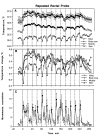Procedure of rectal temperature measurement affects brain, muscle, skin, and body temperatures and modulates the effects of intravenous cocaine
- PMID: 17466279
- PMCID: PMC1974888
- DOI: 10.1016/j.brainres.2007.03.078
Procedure of rectal temperature measurement affects brain, muscle, skin, and body temperatures and modulates the effects of intravenous cocaine
Abstract
Rectal probe thermometry is commonly used to measure body core temperature in rodents because of its ease of use. Although previous studies suggest that rectal measurement is stressful and results in long-lasting elevations in body temperatures, we evaluated how this procedure affects brain, muscle, skin, and core temperatures measured with chronically implanted thermocouple electrodes in rats. Our data suggest that the procedure of rectal measurement results in powerful locomotor activation, rapid and strong increases in brain, muscle, and deep body temperatures, as well as a biphasic, down-up fluctuation in skin temperature, matching the response pattern observed during tail-pinch, a representative stressful procedure. This response, moreover, did not habituate after repeated day-to-day testing. Repeated rectal probe insertions also modified temperature responses induced by intravenous cocaine. Under quiet resting conditions, cocaine moderately increased brain, muscle, and deep body temperatures. However, during repeated rectal measurements, which increased temperatures, cocaine induced both hyperthermic and hypothermic responses. Direct comparisons revealed that body temperatures measured by a rectal probe are typically lower (approximately 0.6 degrees C) and more variable than body temperatures recorded by chronically implanted electrodes; the difference is smaller at low and greater at high basal temperatures. Because of this difference and temperature increases induced by the rectal probe per se, cocaine had no significant effect on rectal temperatures compared to control animals exposed to repeated rectal probes. Therefore, although rectal temperature measurements provide a decent correlation with directly measured deep body temperatures, the arousing influence of this procedure may drastically modulate the effects of other arousing stimuli and drugs.
Figures







References
-
- Baker M, Cronin M, Mountjoy D. Variability in skin temperature in the waking monkey. Am. J. Physiol. 1976;230:244–55. - PubMed
-
- Briese E, Cabanac M. Stress hyperthermia: physiological arguments that it is a fever. Physiol. Behav. 1991;49:1153–57. - PubMed
-
- Brown PL, Kiyatkin EA. Brain temperature change and movement activation induced by intravenous cocaine delivered at various injection speeds in rats. Psychopharmacology. 2005;181:299–308. - PubMed
-
- Clark DL, DeBow SB, Iseke MD, Colbourne F. Stress-induced fever after postischemic rectal temperature measurements in the gerbil. Can. J. Physiol. Pharmacol. 2003;81:880–83. - PubMed
-
- Crandall CG, Vongpatanasin W, Victor RG. Mechanisms of cocaine-induced hyperthermia in humans. Ann. Intern. Med. 2002;136:785–791. - PubMed
Publication types
MeSH terms
Substances
Grants and funding
LinkOut - more resources
Full Text Sources

